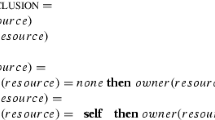Abstract
An approach for modeling dynamic situations where several processes execute concurrently is described. Using the concepts “system execution” and “pomset” defined by Lamport and Gischer, we address basic issues such as: what is an “event”? what is a “state” of a system? how should time be represented? etc.
The notion of a system execution is extended in such a way that a state is just a peculiar system execution, one in which no event precedes another—it is the description of a moment. This allows demonstrating the duality within a single framework of two approaches to modeling concurrency: the one based on events and the other on states.
Similar content being viewed by others
Explore related subjects
Discover the latest articles, news and stories from top researchers in related subjects.References
K. R. Popper,The Logic of Scientific Discovery, Basic Books: New York, 1959.
N. Wiener, “A contribution to the theory of relative position,”Proc. Camb. Philos. Soc. vol. 17, pp. 441–449, 1914.
L. Lamport, “On interprocess communication, part I: Basic formalism, Part II: Algorithms,”Dist. Comp., vol. 1, pp. 77–101, 1986.
J. Gischer, “The equational theory of pomsets,”Theoret. Comput. Sci. vol. 61, pp. 199–224, 1989.
V. Pratt, “Modeling concurrency with partial orders,”Int. J. Parallel Prog. vol. 15, pp. 33–71, 1986.
A. A. Robb,The absolute relations of time and space, Cambridge University Press, 1921. Cited inThe Concept of Space and Time (The conical order of time-space), edited by M. Capek, D. Reidel: Boston, 1976.
S. Ben-David, “The global-time assumption and semantics for distributed systems,” in7th ACM Symp. on Principles of Distributed Computing, 1988, pp. 223–232.
H. Gaifman, “Modeling concurrency by partial orders and nonlinear transition systems,” inLinear Time, Branching Time and Partial Order in Logics and Models for Concurrency: Lecture Notes in Computer Science, vol. 354, Springer-Verlag: New York, 1989, pp. 467–488.
J. Gischer, “Partial orders and the axiomatic theory of shuffle,” Ph.D thesis, Computer Science Department, Stanford University, 1984.
P. C. Fishburn,Interval Orders and Interval Graphs, Wiley (Wiley-Interscience series in discrete mathematics): New York, 1986.
L. Lamport, “The mutual exclusion problem: Part I—a theory of interprocess communication,”J. ACM vol. 33, pp. 313–326, 1986.
F. Anger, “On Lamport's interprocess communication,”ACM Trans. Programming Language Syst. vol. 11, no. 3, pp. 404–417, 1989.
D. K. Probst and H. F. Li, “Modelling reactive hardware processes using partial orders,” inSemantics for Concurrency, Proc. Int. BCS-FACS Workshop, Leicester, 1990, pp. 324–343.
L. Lamport, “A new approach to proving the correctness of multiprocess programs,”ACM Trans. Programming Language Syst. vol. 1, pp. 84–97, 1979.
U. Abraham, S. Ben-David, and M. Magidor, “On global-time and inter-process communication,” inSemantics for Concurrency, Proc. Int. BCS-FACS Workshop, Leicester, 1990, pp. 311–323.
Author information
Authors and Affiliations
Rights and permissions
About this article
Cite this article
Abraham, U. On system executions and states. Appl Intell 3, 17–30 (1993). https://doi.org/10.1007/BF00871720
Issue Date:
DOI: https://doi.org/10.1007/BF00871720




